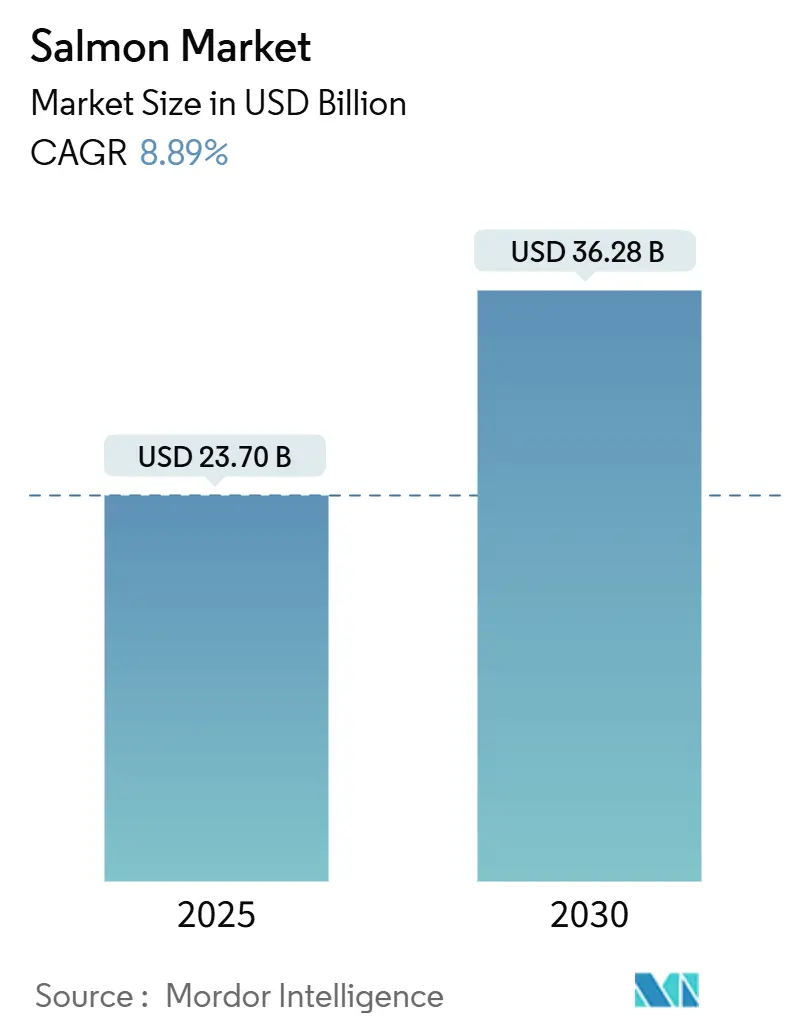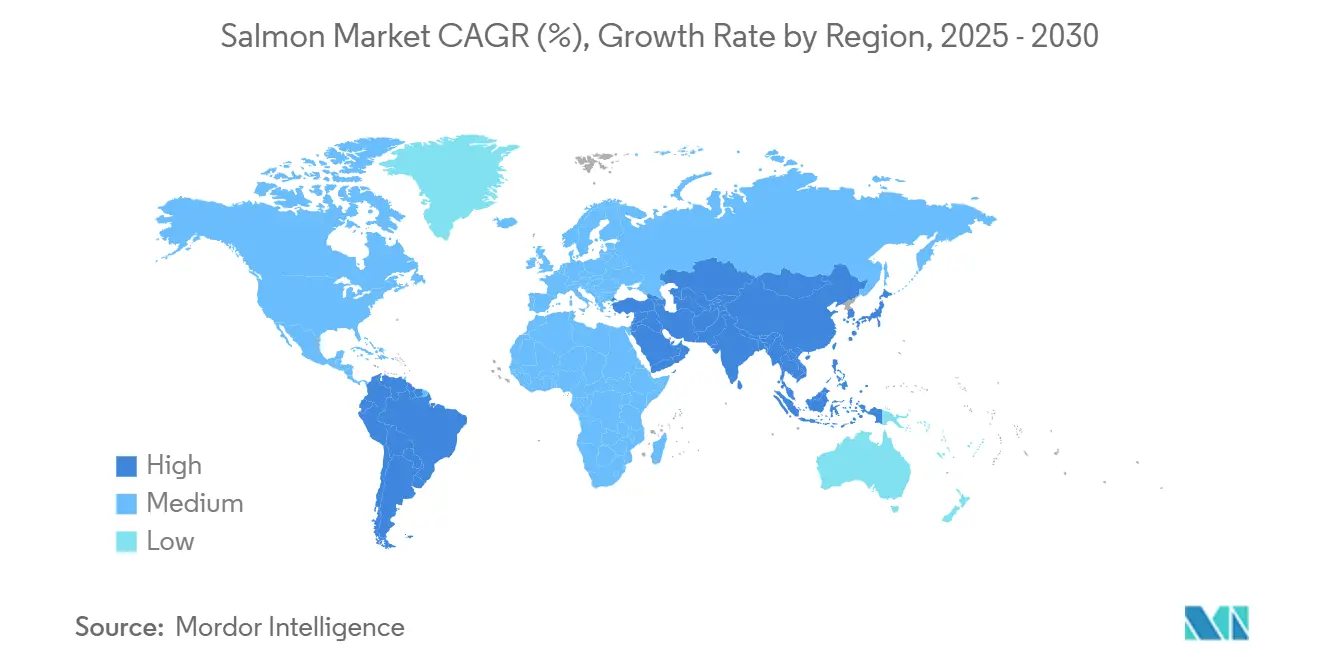Salmon Market Size and Share

Salmon Market Analysis by Mordor Intelligence
The salmon market, valued at USD 23.7 billion in 2025, is anticipated to reach USD 36.28 billion by 2030, growing at a CAGR of 8.89%. This growth stems from salmon's status as a nutrient-dense, premium protein, with its expansion rate exceeding that of the general seafood category. Supply growth is supported by a 4.0% increase in production capacity in 2025, primarily from Norway and European facilities. Market dynamics are shifting due to new U.S. tariffs and increased Chinese demand. Land-based recirculating aquaculture systems (RAS) and offshore cages are transitioning from pilot to commercial operations, supported by North American and Asian policy initiatives.
Key Report Takeaways
- By geography, Europe led revenue in 2024 at 42.2%, and Asia-Pacific is on track to outpace the 6.4% CAGR for the salmon market through 2030 on the back of a 56% jump in Chinese imports in early 2025.
Global Salmon Market Trends and Insights
Drivers Impact Analysis
| Driver | (~) % Impact on CAGR Forecast | Geographic Relevance | Impact Timeline |
|---|---|---|---|
| Rising demand for healthy, omega-3-rich protein | +2.5% | Global, with a stronger impact in North America, Europe, and Asia-Pacific | Long term (≥ 4 years) |
| Expansion of aquaculture capacity and RAS/offshore systems | +2.1% | Norway, Chile, Scotland, Canada, Australia | Medium term (2-4 years) |
| Government incentives and pro-aquaculture policies | +1.8% | Asia-Pacific, North America, Europe | Medium term (2-4 years) |
| Boom in value-added retail and e-commerce salmon formats | +1.4% | North America, Europe, China, Japan | Short term (≤ 2 years) |
| DNA traceability and blockchain boost consumer trust | +1.2% | Europe, North America, Japan | Medium term (2-4 years) |
| Net-zero protein sourcing pledges by multinationals | +0.9% | Global, with initial impact in Europe and North America | Long term (≥ 4 years) |
| Source: Mordor Intelligence | |||
Rising demand for healthy, omega-3 rich protein
Global per-capita seafood intake climbed, validating salmon’s positioning as a health-forward protein[1]Source: Food and Agriculture Organization, “FAO Report: Global fisheries and aquaculture production reaches a new record high,” fao.org. Spain illustrates the trend that salmon purchases increased between December 2023 and November 2024, even as total fish volumes fell. Omega-3 research linking intake to heart and cognitive benefits underpins sticky demand that holds up during price spikes. In high-income markets, shoppers view salmon less as a discretionary luxury and more as a diet staple, cushioning the salmon market against macroeconomic volatility.
DNA traceability and blockchain boost consumer trust
With mislabeling affecting around 40% of global seafood, proof of origin is now a differentiator. DNA barcoding and distributed-ledger platforms cut mislabeling in certified supply chains to under 1%, allowing sellers of verified salmon to capture a provenance premium. Retailers in Europe and North America increasingly stipulate electronic traceability, embedding technology adoption into the competitive calculus of the salmon market.
Government incentives and pro-aquaculture policies
The United States’ 2023-2028 Strategic Plan for Aquaculture seeks to trim a seafood trade deficit by easing permit hurdles and funding infrastructure[2]Source: National Science and Technology Council, “Strategic Plan for Aquaculture Economic Development (2023-2028),” ars.usda.gov. Singapore’s “30 by 30” program supports domestic salmon farming as part of a broader food-security agenda, while Norway’s traffic-light system ties capacity to environmental metrics. The Fish Site Mixed regulatory stances reward diversified producers able to spread risk across jurisdictions and leverage local incentives.
Boom in value-added retail and e-commerce salmon formats
Convenience is redefining retail; ready-to-cook fillets, smoked spreads, and meal-kit portions are lifting average selling prices. Spanish demand is forecast to remain driven by “quality and convenience” beyond 2025. During the pandemic, online seafood sales spiked and have held gains, giving vertically integrated producers a high-margin, direct-to-consumer channel. Branded lines such as Camanchaca’s Único illustrate how processors monetize this shift.
Restraints Impact Analysis
| Restraint | (~) % Impact on CAGR Forecast | Geographic Relevance | Impact Timeline |
|---|---|---|---|
| Disease outbreaks and high mortality | -1.8% | Norway, Chile, Scotland, Canada | Medium term (2-4 years) |
| Environmental/licensing pushback on open-net pens | -1.4% | Canada, Washington State, Europe | Long term (≥ 4 years) |
| Seafood mis-labeling scandals undermine confidence | -0.9% | Global, with higher impact in North America and Europe | Short term (≤ 2 years) |
| Rise of alternative/cultivated seafood substitutes | -0.7% | North America, Europe | Long term (≥ 4 years) |
| Source: Mordor Intelligence | |||
Environmental/licensing pushback on open-net pens
Canada plans to phase out open-net salmon farming in British Colombia by 2029, while Washington State has banned these pens in public waters. Environmental impact concerns drive similar regulatory discussions across Europe. The transition to closed containment systems requires significant capital investment, which may lead to industry consolidation as smaller operators face challenges in upgrading their facilities.
Rise of alternative/cultivated seafood substitutes
Plant-based hot-smoked “salmon” made from seaweed and legumes has entered European shelves, and cell-cultured sashimi-grade fillets are progressing through pilot trials. Although alternative seafood held only 0.1% of U.S. sales in 2024, venture funding and retail support could siphon premium demand segments over the next decade, trimming the long-run growth of the salmon market.
Geography Analysis
Europe remains the largest regional slice of the salmon market, accounting for 42.2% in 2024, buoyed by high per-capita consumption and a dense network of chilled logistics. Norwegian exporters preserved value despite a 6% NOK/EUR depreciation[3]Source: Trade Council, “Scottish salmon exports reach record GBP 844 million (USD 1,133.6 million),” tradecouncil.org. Consumer demand skews toward certified sustainable labels, making traceability an entry ticket. Norway’s traffic-light rules tie biomass to sea-lice metrics, forcing adaptive farming but preserving wild stocks, a balance applauded by regulators.
The Asia-Pacific region shows the fastest growth, accounting for 6.4% CAGR of the market. Chinese imports of Norwegian salmon increased their market share in early 2025, recovering from the decline. Growing disposable incomes and changing urban dietary preferences drive the consumption of premium protein sources. While Japan focuses on sashimi-grade quality, China shows a preference for value-added and ready-to-cook products. Regional governments are developing domestic production capabilities, as evidenced by South Korea's RAS facility and Singapore's goal of 1,000 metric tons of annual production. However, regional production volumes remain significantly lower than demand, indicating continued dependence on imports.
North America maintains its significant position in the salmon market. Washington State's ban on open-net pens and Canada's planned phase-out in British Columbia by 2029 is pushing producers to adopt closed containment systems. This transition increases capital expenditure requirements but creates opportunities for technology providers. Consumer awareness regarding product origin and authenticity continues to grow, as evidenced by DNA audits in Seattle revealing 18% mislabeling of salmon products. This finding has prompted retailers to require comprehensive traceability systems.

Recent Industry Developments
- May 2025: Salmon Evolution recorded a 45% quarter-on-quarter biomass increase and advanced Phase 2 of its Indre Harøy facility.
- March 2025: Kelly Cove Salmon acquired a former AquaBounty facility in Prince Edward Island to expand smolt capacity and install an additional RAS unit.
- March 2025: SalMar assumed full ownership of its offshore subsidiary after purchasing Aker’s 15% stake.
- January 2025: South Korea commenced operations at its first land-based salmon farm using AKVA technology.
Research Methodology Framework and Report Scope
Market Definitions and Key Coverage
Our study defines the global salmon market as the revenue earned when farmed or wild-caught salmon sold whole, filleted, frozen, smoked, canned, or fresh leaves a processor or an importer at its first commercial sale.
Scope exclusions include fishmeal, collagen, oil, leather, and any other by-products from salmon off-cuts that sit outside this review.
Segmentation Overview
- By Geography (Production Analysis (Volume), Consumption Analysis (Volume and Value), Import Analysis (Volume and Value), Export Analysis (Volume and Value), and Price Trend Analysis)
- North America
- United States
- Canada
- South America
- Chile
- Europe
- Norway
- United Kingdom
- France
- Spain
- Italy
- Netherlands
- Greece
- Asia-Pacific
- China
- Japan
- Australia
- Middle East
- Iran
- Turkey
- Africa
- South Africa
- North America
Detailed Research Methodology and Data Validation
Primary Research
Mordor analysts interviewed RAS engineers, feed makers, import distributors, and chilled seafood buyers across Europe, Asia-Pacific, and North America. These conversations tightened biomass ceilings, realistic ex-farm prices, and regional consumption elasticities before we locked the figures.
Desk Research
We began with FAO FishStat harvest series, Norway Directorate of Fisheries export dashboards, UN Comtrade codes, and USDA GATS price lists that map volume-price flows worldwide. Trade bodies such as the Norwegian Seafood Council and SalmonChile then highlighted licensing shifts, disease events, and feed norms that sway biomass. Company filings gathered through D&B Hoovers and news preserved in Dow Jones Factiva revealed capacity moves, while peer-reviewed journals clarified omega-3 demand and RAS efficiency. These sources are illustrative; many other public and paid references guided data checks and clarification.
Market-Sizing & Forecasting
A single top-down pass multiplies each producing country's harvest and wild catch by sampled first-sale prices to set the 2024 base. It then cross-checks this with selective bottom-up producer roll-ups. Five fingerprints, harvest volume, average export price, feed-cost index, new RAS capacity, and per-capita seafood intake feed a multivariate regression that extends the series to 2030; elasticities plug unavoidable gaps.
Data Validation & Update Cycle
Model outputs face variance thresholds; any swing above seven percent versus trend triggers anomaly reviews, extra calls, and model edits. We refresh every study yearly and issue interim flashes whenever disease, trade, or currency shocks materially move the baseline.
Why Mordor's Salmon Baseline Earn Dependable Trust
Published estimates often diverge because firms slice product mix, price point, and geography differently and refresh on uneven calendars.
Key gap drivers we observe are the exclusion of processed formats, reliance on retail receipts, dated baselines, and blanket growth rates that miss the North American RAS build-out.
Benchmark comparison
| Market Size | Anonymized source | Primary gap driver |
|---|---|---|
| USD 23.70 bn (2025) | Mordor Intelligence | - |
| USD 19.10 bn (2024) | Global Consultancy A | Omits smoked & canned, five regions, biennial updates |
| USD 30.59 bn (2025) | Regional Consultancy B | Uses retail values and single 6.7 percent CAGR, lacks supply checks |
| USD 15.96 bn (2022) | Trade Journal C | Old base year, constant 2021 prices, ignores new farms |
Together, the comparison shows that Mordor Intelligence's disciplined scope, variable selection, and annual review give decision-makers a transparent baseline traceable to real harvest data and repeatable steps.
Key Questions Answered in the Report
What is the current size of the salmon market?
The salmon market is valued at USD 23.7 billion in 2025 and is projected to reach USD 36.28 billion by 2030.
Which region is growing fastest in salmon demand?
Asia-Pacific leads growth, with Chinese imports of Norwegian salmon rising 56% year on year in early 2025.
Why are RAS and offshore farming gaining attention?
They offer tighter biosecurity, meet emerging environmental regulations, and can be sited away from crowded coastlines, supporting long-term supply stability.
What impact do U.S. tariffs have on the salmon market?
New U.S. duties of 10–20% on most imported salmon raise retail prices and are projected to divert trade flows toward Asia and intra-European markets.
How does DNA traceability benefit consumers and producers?
Traceability reduces mislabeling to below 1% in certified chains, bolstering consumer trust and allowing verified suppliers to earn price premiums.
Page last updated on:

